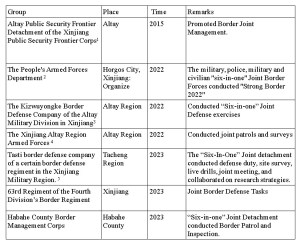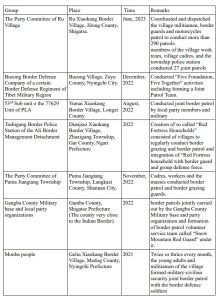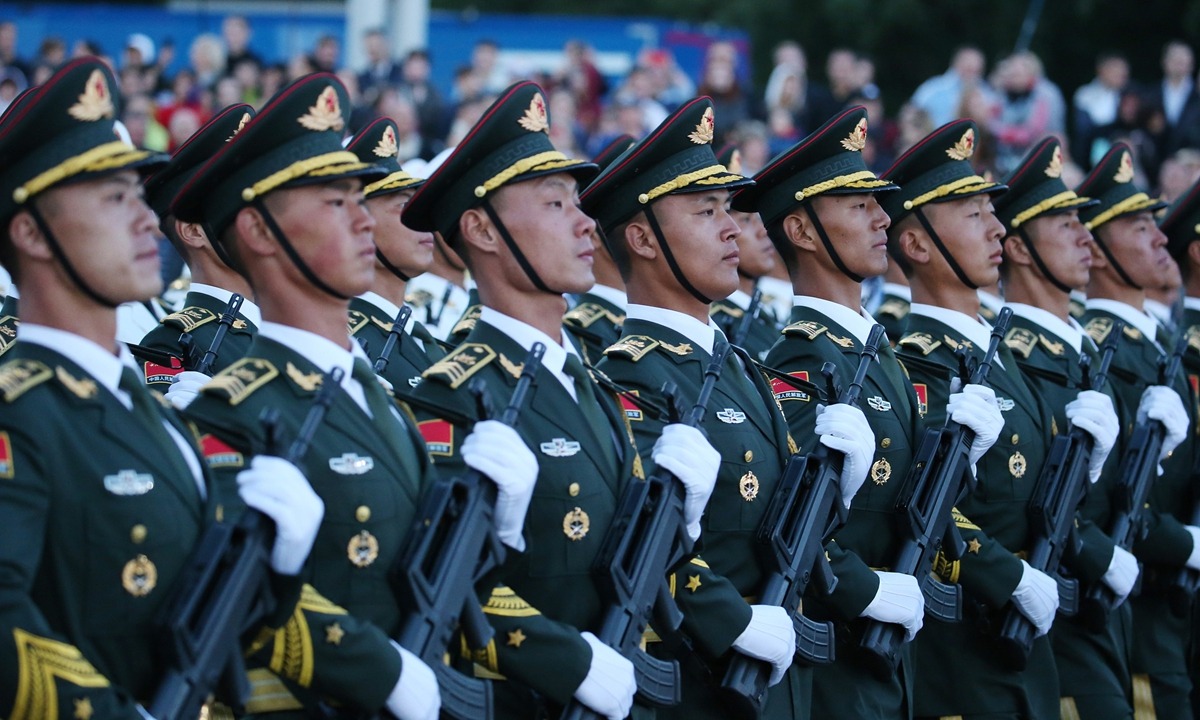OPED By Tenzin Younten
One of the recent significant developments along the Tibet and Xinjiang border areas seems to be China’s repeated attempts to significantly improve its military-civilian joint border defense capabilities against India and other neighboring countries.
The capabilities enhancement has been sought through relentless promotions of campaigns such as “Six in One” Joint Defense and Control in Xinjiang Autonomous Region (East Turkestan), “Five in One” Border Management System, and “Five Foundation, Five Together” in Tibet Autonomous Region (TAR).
These campaigns have aimed to establish strong border defense teams consisting of civilians, policemen, militiamen, and party and government officials working with People’s Liberation Army soldiers towards border defense and management.
These campaigns constantly remind us that the responsibility for defending the border areas of Tibet and Xinjiang is not only on the People’s Liberation Army’s border defense forces or the border police station’s officers but also on the civilians residing in the border areas, including in Xiaokang Border Villages, and that they should also become a critical part of the Chinese border defense team.
It is frequently reminded that the strength of the military and police is limited, but the power of the people is infinite. In the context of recent border clashes between India and China, it is pertinent to understand these campaigns aimed at strengthening its border defense and security in the Tibet Autonomous Region and Xinjiang Autonomous Region and the scale of their implementation in Tibet and Xinjiang.
If this Joint Border Defense model is successfully implemented in Tibet and Xinjiang, it could tremendously strengthen both external security against India and internal security and stability in Tibet and Xinjiang.
Nonetheless, from the pragmatic point of view, it seems there are multiple issues regarding the applicability of implementing the Joint Military-Civilian Border Defense Forces in both Tibet and Xinjiang propagated by these campaigns.
The impractical of such campaigns stems from three primary reasons: the nature of the border, fault in the joint implementation of the border tasks, and mainly the civilians living in the border areas.
Such campaigns to install a model of Joint Military Civilian border defense in Tibet’s border areas are primarily the works of the Political Work Department, and they serve as a means to achieve their propaganda goal rather than a military goal.
“Six-in-One” Joint Border Defense And Joint Control: Xinjiang Autonomous Region
The “Six-in-One” Joint Defense and Control is an essential part of China’s campaign to strengthen both the Civilian Military Fusion and the border defense by creating joint border defense forces or a team consisting of six members, which are the “People’s Liberation Army, Militia, Police, Government Officials, Party and Civilian” in Xinjiang.
It is precedent to witness China’s forceful and repeated attempts to foster strong cooperation and partnership between the Civilian and Military in both autonomous regions. However, a policy such as the “Six-in-One” Joint Defense and control specially designed model to be implemented in the border areas demands more substantial attention from its neighboring countries.
Through this policy, the civilians, police, militiamen, party & state officials in the border areas are dictated to participate in the joint border defense tasks and responsibilities and conduct Border patrol, drills, exercises, reconnaissance, and other border military activities have become mandatory duties.
The “Six-in-One” was implemented in Xinjiang as early as 2015 when the Altay Public Security Frontier Detachment of the Xinjiang Public Security Frontier Corps established and promoted border joint management in their region. Although it was started some years ago, the promotion and implementation of such a model have recently become more pervasive in Xinjiang.

“Five Foundation, Five Together” And “Five In One” Joint Border Management System: Tibet Autonomous Region
The “Five Foundation, Five Together” campaign was comprehensively launched in the 21 border counties of Tibet recently. With the upsurged promotions of the “Five Foundation, Five Together” movement in the Tibet Autonomous Region, China attempted to demonstrate an improvement of the Joint Military, Police, and Civilian border defense cooperation and capabilities also portrays a strong and supportive relationship between the civilians and army in the border areas of Tibet.
The “Five Foundation, Five Together” is a crucial part of the Communist Party of China’s propaganda campaign to comprehensively organize the joint construction of military and local party organizations in the Tibet Autonomous Region and other regions of China. The joint structure of the local party organization and military is based on the five foundations, which are:
- Learn the Communist Party’s principles and cultivate strong faith in the party.
- Jointly construct the local organization and build a solid base.
- Promote the improvement of people’s livelihood and consolidate the achievements of poverty alleviation campaigns.
- Build a new style of civilization and foster national unity.
5. Defend the sacred land and solidify the border stability.
Implementing the “Five Foundation, Five Together” denotes the integration of military, police, and civilians to solidify border defense, border security, and party rule in the border areas. In recent years, there has been an upsurge in promoting and implementing the “Five Foundation, Five Together” in the Border Counties and Prefecture of Tibet.
On April 27, 2022, the promotion meeting of the policy was held in the Ngari Prefecture, which the director of the Political Work Department of Ali Military Division of Tibet Military Region attended. The meeting stressed promoting the construction of a significant and systematized military-civilian joint defense at the borderline.
At the Nyingchi City’s promotion meeting of “Five Foundation, Five Together” held in Zayu County in December 2022, the focus of the forum stated that the work conducted under this policy created a demonstration area of consolidating borders, revitalizing border and deepening the integration of military and civilian in Nyingchi to strengthen the border defense jointly.
Through the “Five Foundation, Five Together” campaign, Civilians in border areas decreed to support the Border Defense Forces in carrying out patrol and other border duties. There have been recent signs of urgency in promoting and mandating the implementation of this campaign in Tibet Border Areas, including Xiaokang Border Villages.
Similar to the Xinjiang model of “Six-in-One” Joint Border Defense, the “Five-in-One” Border Management system has been heavily promoted in the border areas of Tibet. The “Five-in-One” policy attempts to create a comprehensive Joint Border Management System or model consisting of five members: a party, government, military, police, and civilians who will ensure border stability and security.
Promoting the “Five-in-One” Border Management System has recently become common in Tibet’s border areas. Such policies are rooted in their belief that “a Border civilian is a guard, a family is a watch post, and a village is a fortress.” In many instances, civilians in the Xiaokang Border Villages in the Tibet Autonomous Region are encouraged to work with the Border Defense soldiers and contribute towards border defense.
For instance, the Monba people of the Gelin Village (One of the Xiaokang Border Village) located in Medog County protect its border as the young adults and militiamen of the village formed military-civilian security joint border patrol with the border defense soldiers.
On the Himalayan foothills at 4,700 meters altitude, situated near the Indian border, the Gamba County of Shigatse prefecture had built a strong border defense by forming a “five-in-one” border security management system and forming border patrol volunteer service team called “Snow Mountain Red Guard” under it. Such model implementation has also become prominent in other areas of Tibet’s border.
On the one hand, the pervasive adoption of such a Joint Military Civilian Border Defense Model promulgated by such campaigns in Tibet would possibly mean a significant bolstering of Tibet’s Border Defense Capabilities.
This is achieved by providing a platform through which the different Border Defense Regiments of Tibet Military Region, a few of the Border Defense Regiments of Xinjiang Military Region under the jurisdiction of Ali Military Region, the police officers of more than 30 Border Police Stations, the militiamen, Party committee officials, state officials; and lastly the civilian presented in the 624 Xiaokang Border Villages and other border areas to defend the border against India effectively.
Moreover, if it can be implemented, it would lead to a systematic formation of a Border Defense Team of civilians, soldiers, militiamen, and other members in all the 21 border counties of the Tibet Autonomous Region. But on a closer look, there are clear indications of its faulty nature over its implementation and vital signs that it is doomed to fail.

Conclusion
There is a huge question looming over the effectiveness of the “Five in One” Joint Border Management and the “Five Foundation, Five Together” in the Tibet Autonomous Region or, more so, over the possibility that these campaigns will lead to a more systematic mechanism of ensuring an effective border defense against India during the peacetime as well as wartime.
However, there are multiple indications that the joint civilian-military border defense spouted by these campaigns will eventually fail or that these activities associated with such a model are more likely aligned with propaganda than military purposes.
India and China share a long, contentious, un-demarcated border called the “Line of Actual Control” in the Tibet Autonomous Region. The idea of Joint Civilian Military Border Defense activities along these un-demarcated border lines prone to skirmishes and clashes seems far-fetched.
There are many operational problems during the model implementation due to the ardent nature of border tasks, the differences in capabilities between the members, and the lack of coordination and organization.
Apart from the threat of military confrontation and skirmishes, soldiers conducting border defense task and securing China’s border faces one of the most complex geography, frequent natural disasters, and harsh climate, which demands a particular set of strength and expertise.

Furthermore, the dangerous patrol path the border soldiers routinely embarked on necessitates specific skills and competence. Again, there is an immense gap between the capabilities of the border defense soldiers and the police officers and civilians, which would hamper the completion of border patrol tasks and operations.
Although these campaigns aim to establish military-civilian cooperation in border defense, there seems to be an absence of a unified organization and command system between the different units of this model. In both Tibet and Xinjiang, joint border patrols and activities under the banners of these campaigns are on the rise. Still, there seems to be a lack of coordination mechanisms, clear responsibilities, and operational procedures between the different units.
Similar to the problem faced in the implementation of the actual operating process of the emergency response work, the Joint Military Civilian Border Defense model in Tibet and Xinjiang faced the issues of lack of detailed regulations on the responsibilities and obligations, methods of coordination, organization, and command procedure and inspection system of the different units in this model.
Lastly, one of the main reasons why the implementation of this model of Joint Military-Civilian Border Defense is doomed to fail is because of the people.
The success of this model is determined by the participation and willingness of the civilians living in the border areas of the Tibet Autonomous Region, who are mainly Tibetan, to actively support and conduct Joint Border duties with the army and police.
The primary goal of these campaigns is to portray a solid and supportive relationship between the Tibetan and the Chinese army and that Tibetans are defending the sovereignty and integrity of the motherland. Such campaigns continue the decades-long concerted efforts by the Chinese Communist Party to portray a fabricated image that the Tibetan people are happy and have embraced the rule of the CCP.
This Military Civilian Joint Border Defense model is simply the lack of willingness among most Tibetan people living along the borders as it would require coercion to support the Chinese government and its army. Before the Chinese annexation of Tibet in the 1950s, Tibet was an independent country whose vast territory consisted of the present-day Tibet Autonomous Region, parts of Gansu, Qinghai, Sichuan, and Yunnan provinces.
The Chinese invasion of Tibet has led to the death of more than 1 million Tibetans. And more so, the repressions, violations of fundamental human rights, and acts of genocide in Tibet committed since the Chinese invasion have been recorded in the International Court of Justice.
Several UN and international reports concluded that “acts of genocide had been committed and that “Tibet was at the very least a de-facto independent state.” The situation in Tibet and Xinjiang has worsened under the CCP’s rule.
Currently, both Tibetan and Uyghur face the existential threat of cultural genocide, including mass internment camps, indoctrination of Tibetan children in colonial boarding schools, mass forced resettlement of Tibetan nomads and pastoral, mass coercive vocational training programs, and flagrant violations of fundamental rights aim at the eradication of distinct identity of the concerned groups.
The Military-Civilian Joint Border Defense model introduced through these campaigns aims to paint a rosy picture of unity, brotherhood, and love for the Party and China in Tibet and Xinjiang and propagate the CCP’s broken record of “Happy and Prosperous Tibet.”
This model will never fully work in Tibet or Xinjiang as it negates the nature of the ground realities of the status and the conditions of both Tibetan and Xinjiang, which remains far from the delusional image spouted by the CPC’s propaganda machine and the failure of these campaigns are rooted in such delusions created by the party itself.
- Tenzin Younten is a Research Analyst at the Centre for Contemporary Studies in Security and Technology. VIEWS PERSONAL
- Follow EurAsian Times on Google News




